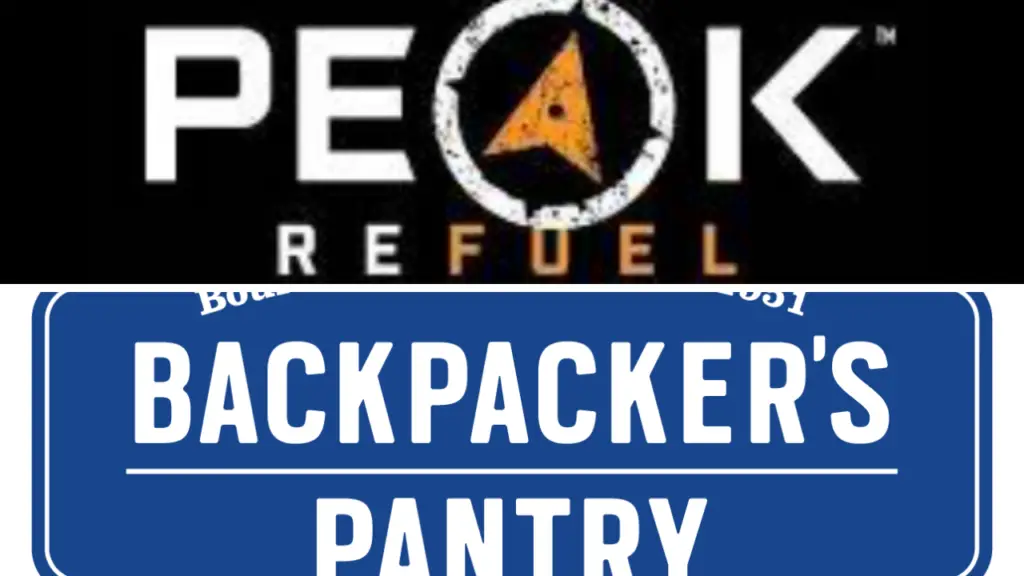
Peak Refuel vs. Backpackers Pantry meals have a lot of bang for your buck, and there’s a lot to choose from. Dinner preparation is quick and straightforward. In addition, they have a short cook time and require less water than some other dehydrated hiking meals.
Peak Refuel
Peak Refuel is another interesting backpacking food company. They have already made an impression with a competitive range of high-energy meals for your next excursion. With an average of 155 calories per ounce and one of the highest protein levels of any option, these entrees pack a strong punch of about 22.5 grams per serving.
Peak Refuel’s entrees, like Backpackers pantry, are freeze-dried, which means they rehydrate in just 10 minutes and with less water than dehydrated pouch meals. So peak Refuel is a good option if you’re searching for a quick and straightforward way to refuel after a long day.
There are a few drawbacks to choosing such a calorie- and power-dense option. First, peak Refuel’s menu is quite traditional and noodle-heavy. On the other hand, they promote unique and high-quality ingredient lists. Furthermore, double-serving quantities aren’t suitable for solo hikes—with nearly 1,000 calories in each pouch, many hikers will have to share or reserve some later. You may enjoy dinner for two for just $13, which is less expensive.
Peak refuel backpacking food
One of the most popular posts is a round-up of my favorite easy camping dinners and snacks. Only a few large backpacking food manufacturers have recently, but Peak Refuel focused on making healthier, more natural backpacking food with fewer chemicals.
Taste at its best
Consequently, we tried the Sweet Pork and Rice dish in a real kitchen at home. We dug in after ten minutes, and the pork had a smokey flavor with a tinge of brown sugar, as well as the texture of pulled pork sandwiches. Corn, black beans, and red peppers are added to the mix for a little extra zing.
We also tried Peak Refuel’s backpacking dinners, the Chicken Alfredo, and the Sweet Pork and Rice. Peak Refuel did a fantastic job with the Chicken Alfredo. The sauce has just the proper amount of creaminess without being overpowering.
Well-seasoned, with a hint of pepper and garlic, it featured great chunks of chicken that tasted like real chicken, rather than the spongy meat chunks found in many backpacking meals. They use actual ingredients, but everything in their meals is non-GMO certified.
Peak Refuel has earned my favorite backpacking meals due to my positive experience with them.
Backpacker’s Pantry
For meals for Backpackers on a Budget, the Backpacker’s Pantry ($6 – $13). The Backpackers Pantry is a food store for backpackers, and the pouch is a cooking method with a cooking time between 15-20 minutes on average, and it contains 113 calories per ounce.
The Backpacker’s Pantry has been producing dehydrated meals for quite some time now and is still one of the most well-known backpacking food businesses. Also, the company offers one of the most comprehensive backcountry meal selections available, with various gluten-free, vegan, and organic options.
Favorites include Jamaican Jerk Rice with Chicken, Kathmandu Curry, and Pad Thai. The discerning palate comes with a small package of peanut butter and separately packaged peanuts. All Backpacker’s Pantry meals are MSG-free and have a 7-year shelf life if you don’t know this. But for the bulk cans, it is 25 years shelf life.
Backpacker’s Pantry has the title of most ubiquitous backcountry meal with just about any outdoor store. Their food is inexpensive, and they come in flat, packable pouches with colossal serving sizes and a variety of exceptional diet alternatives.
The meals taste better and provide outstanding value at 76.7 calories, and some of their two-serving dishes, such as Louisiana Red Beans and Rice, cost low. So even though a Backpacker’s Pantry dinner will take a little longer to prepare, it has value.
Prepare meals
Peak Refuel and Backpackers Pantry dinner preparation is quick and straightforward. They have a short cook time of 10 minutes and require less water than some other dehydrated hiking meals.
Pour boiling water into the bag, mix, and cook for 10 minutes to prepare them. You can use the meal packaging to pack out any rubbish you’ve amassed throughout the day; there are no dishes or clean-up after you eat.
Nutrition at its best
Peak Refuel vs. Backpackers Pantry meals are tasty, and qualify as a decent backpacking meal. However, they are calorie-packed and give enough energy to propel you uphill while wearing a hefty pack. Compared to the usual backpacker lunch, Peak Refuel and Backpackers Pantry meals provides a lot of protein, fat, and calories.
Is backpackers Pantry any good?
Over the years, I’ve eaten many Backpacker Pantry dinners. Dehydrated food is light, simple to prepare (add hot water), and delicious. Cleaning up is also a breeze when eating straight from the bag.
Are backpacking meals healthy?
While many healthful meals require refrigeration, trekkers may enjoy a variety of shelf-stable, nutritional options while on the trail. For health-conscious hikers, dehydrated meals, nuts, seeds, dried fruit, nut butter, aged cheeses, and whole grains are just a few of the alternatives.
Can you live off freeze-dried food?
Freeze-dried food is undoubtedly a viable option. It’s not dissimilar to eating fresh cuisine. It’s almost the ideal method for preserving non-perishable survival food. If you eat a balanced mix of fruits, meats, and veggies, you can survive on freeze-dried survival food.
